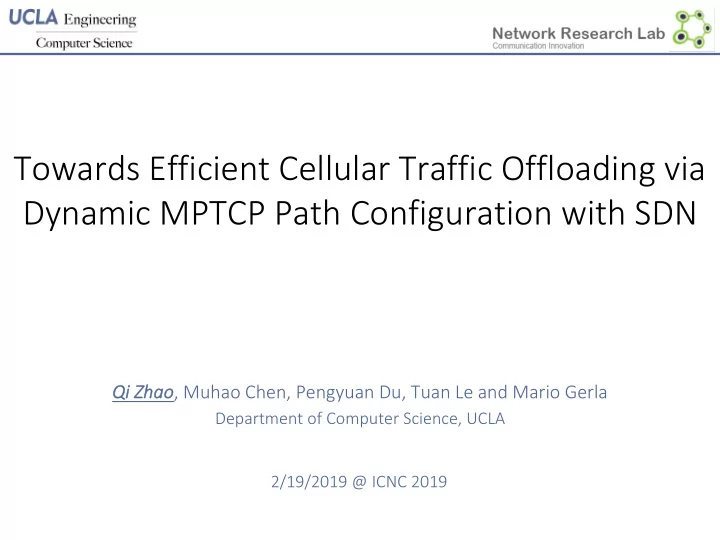

Towards Efficient Cellular Traffic Offloading via Dynamic MPTCP Path Configuration with SDN Qi Qi Zhao Zhao , Muhao Chen, Pengyuan Du, Tuan Le and Mario Gerla Department of Computer Science, UCLA 2/19/2019 @ ICNC 2019
Outline § Introduction § Problem Identification § Solution Design § Evaluation § Conclusion 2 of 22
Introduction § Trend of Future mobile wireless system § The explosion of mobile communications § 18-fold increase of Mobile data traffic over the past 5 years § 60% of the total is rich multimedia content Exabytes per Month 49 35 24 17 11 7 2016 2017 2018 2019 2020 2021 3 of 22
Introduction § Modern mobile devices are commonly equipped with multiple network interfaces § WiFi & Cellular § Traffic offloading & Network handover 4 of 22
Introduction § Many solutions have been proposed § Mobile IP § Provides smooth handover BUT uses one network at a time § Multipath TCP § Simultaneously utilizes multiple communication paths § Smoother reaction to network failure § Work over today’s networks 5 of 22
Outline § Introduction § Problem Identification § Solution Design § Evaluation § Conclusion 6 of 22
Problem Identification § MPTCP still has performance issue § Lowest-Delay-First scheduler will send the packets to the link with lowest RTT first and then other links with higher RTT § Users only have their own local view of the network § With multiple users in network, the link with lowest RTT will be congested though there may be more available bandwidth on other network links How to select path(s) for each MPTCP user in the same network? How much bandwidth should each MPTCP user utilize for each path? 7 of 22
Outline § Introduction § Problem Identification § Solution Design § Evaluation § Conclusion 8 of 22
Solution Design § Quantify the Quality of Links § Throughput ratio tells that how the overall performance of MPTCP will be compared to SPTCP § Bandwidth capacity and delay ratios can be used to predict the overall performance of MPTCP compared to SPTCP instead of the actual value of bandwidth capacity and delay 20.835 Mbps / 20 Mbps Link 1 10.234 Mbps / 10 Mbps Client Server Link 2 9 of 22
Solution Design § Generating Data for Model Training § Same topology with a pair of hosts and two links between them § Only change the bandwidth and delay ratios of two links § Link delay ratio: range(1, 1000) § Link bandwidth ratio: [0.1, 0.125, 0.25, 0.5, 1.0, 2.0, 4.0, 6.0, 8.0, 10.0] 10 of 22
Solution Design § Model Training § Radial Basis Function kernel based SVM with 10-fold cross-validation § Model Evaluation § Link delay ratio: randomly select 100 from range(1, 1000) § Link bandwidth ratio: [0.2, 0.4, 0.6, 0.8, 1.2, 2.5, 4.5, 6.5, 8.5, 9.5] Red: Predicted MAE = 0.0573 Black: Simulation Variance = 0.0062 11 of 22
System Architecture Design Perform prediction Periodically inspect the network Deploy the path selection and dynamic and feeds the control module on edge switches by setting adjustment several information to predict the up OpenFlow flow tables best performance path selection Information Path SVM Model Collect Configuration Controller SDN controller WiFi wmediumd LinuxTC wlan eth LTE base stations eth wlan WiFi APs Mobility support MPTCP Linux kernel MPTCP 12 of 22
Software Defined Networking § MPTCP can only manage their sub-flows locally § SDN controller manages sub-flows globally and faster Network Virtualization Well-defined API Other Traffic Routing Security Application Plane Applications Engineering Network Map Abstraction Network Operating System Control Plane Instructions Instructions Instructions Instructions Forwarding Separation of Data and Control Plane Forwarding Forwarding Data Plane Forwarding 13 of 22
Outline § Introduction § Problem Identification § Solution Design § Evaluation § Conclusion 14 of 22
Mininet-WiFi-based Emulation Testbed § Testbed platform: § Linux Ubuntu 14.04 with 8GB RAM § Mininet-WiFi, an extension of Mininet, installed § MPTCP v0.92 and Open vSwitch installed § Experiment with 3 different protocols to evaluate the performance of our proposed solution § Single-path TCP (SPTCP) – baseline § Multi-path TCP only (MPTCP) § Multi-path TCP with SDN control (our system) 15 of 22
Evaluation Scenario § 5 Mobile users & 1 host § 1 OVS switch – LTE station § 50ms backhaul delay § 8Mbps backhaul bandwidth WiFi AP § 50ms propagation delay § Station link bandwidth § [1, 2, 3, 4, 5]Mbps for Sta1 - 5 Movement LTE Connection § 1 OVS AP – WiFi AP WiFi Signal Range § 802.11g wireless network Sta1 Sta2 Sta3 Sta4 Sta5 § 8Mbps backhaul bandwidth § 60s total time and users moves into the AP’s range at 30s 16 of 22
Experiment Results - SPTCP § Communication interruption for all stations at around 30s § Average throughput almost remains the same Average 6.617Mbps Average 6.953Mbps LTE WiFi 17 of 22
Experiment Results - MPTCP § Throughput still suffers when new link joins in § Average 6.832Mbps before users have WiFi access and 13.926Mbps afterwards 18 of 22
Experiment Results - Our System § All stations connect to and utilize the WiFi link almost immediately § Average 15.054Mbps after users have WiFi access, which is 8% higher than MPTCP case Station 5 uses WiFi only after 30s based on the SVM model 19 of 22
Outline § Introduction § Problem Identification § Solution Design § Evaluation § Conclusion 20 of 22
Conclusion § A demonstration of using machine learning algorithm to perform network transmission path selection with accurate prediction for MPTCP § SVM model based path selection module § Support dynamic path adjustment § A deployable system architecture to maximize the network resource utilization, particularly for WiFi and LTE heterogeneous wireless networks, without tremendous network infrastructure and protocol modification 21 of 22
22 of 22
Recommend
More recommend